新目标英语七年级下学案unit1
- 格式:doc
- 大小:193.50 KB
- 文档页数:17
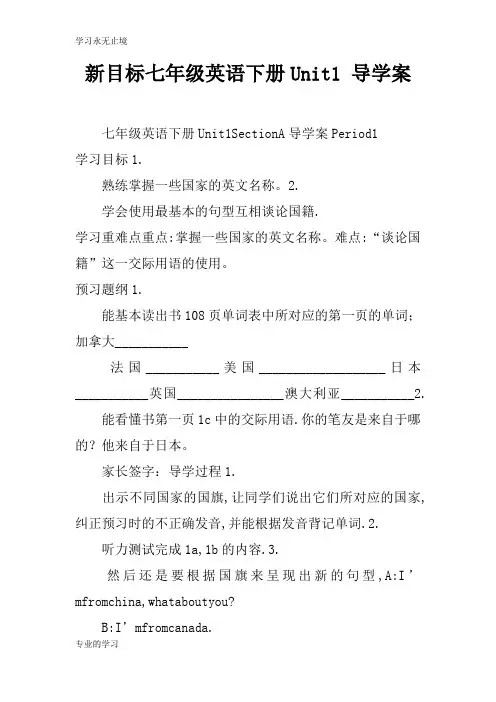
新目标七年级英语下册Unit1 导学案七年级英语下册Unit1SectionA导学案Period1学习目标1.熟练掌握一些国家的英文名称。
2.学会使用最基本的句型互相谈论国籍.学习重难点重点:掌握一些国家的英文名称。
难点:“谈论国籍”这一交际用语的使用。
预习题纲1.能基本读出书108页单词表中所对应的第一页的单词;加拿大___________法国___________美国___________________日本___________英国________________澳大利亚___________2.能看懂书第一页1c中的交际用语.你的笔友是来自于哪的?他来自于日本。
家长签字:导学过程1.出示不同国家的国旗,让同学们说出它们所对应的国家,纠正预习时的不正确发音,并能根据发音背记单词.2.听力测试完成1a,1b的内容.3.然后还是要根据国旗来呈现出新的句型,A:I’mfromchina,whataboutyou?B:I’mfromcanada.c:I’mfromtheSingapore…4.接下来根据上一步,询问旁边的学生他们所听到的信息.Ask:whereisshe/hefrom?链接:befrom=comefromwhereareyoufrom?=wheredoyoucomefrom?等等.七年级英语下册Unit1SectionA堂清试题时间:5分钟得分:________________七年级英语下册Unit1SectionA导学案Period2学习目标1.熟练掌握一些城市的英文名称,知道它们是所属于哪一个国家的。
2.归纳出不同国家的人都说什么语言;哪些国家的人说相同语言.3.询问人们居住的城市,并会回答。
学习重难点重点:掌握一些国家里有名的城市,以及不同国籍的人所说的语言.难点:询问人们居住的城市,以及它们所说的语言预习题纲1.能基本读出书108页单词表中所对应的第2-3页的单词;悉尼__________多伦多__________巴黎___________纽约________________东京____________居住____________语言______________2.能看懂书第一页2d和3b中的交际用语.她住在哪?她住在东京。

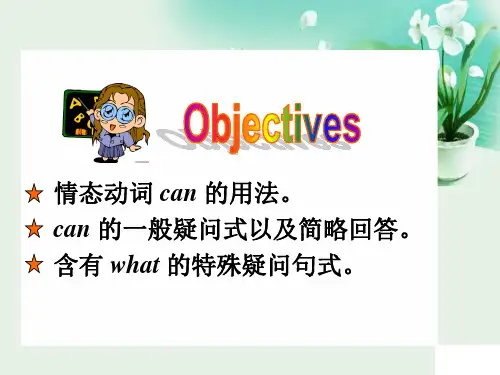
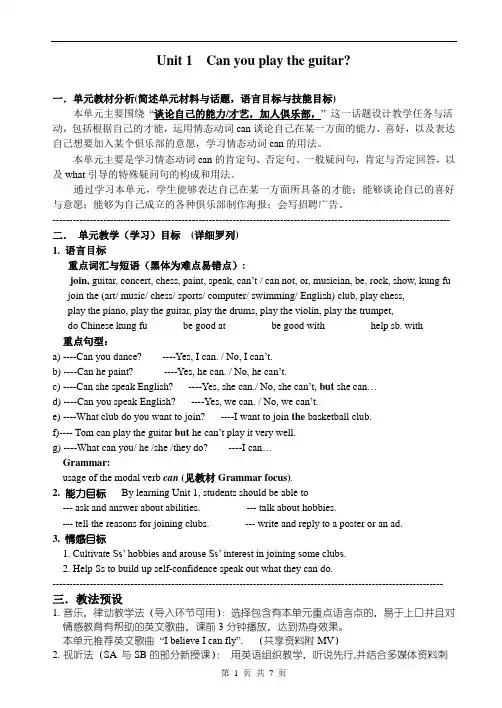
Unit 1 Can you play the guitar?一.单元教材分析(简述单元材料与话题,语言目标与技能目标)本单元主要围绕“谈论自己的能力/才艺,加人俱乐部,”这一话题设计教学任务与活动,包括根据自己的才能,运用情态动词can谈论自己在某一方面的能力、喜好,以及表达自己想要加入某个俱乐部的意愿,学习情态动词can的用法。
本单元主要是学习情态动词can的肯定句、否定句、一般疑问句,肯定与否定回答,以及what引导的特殊疑问句的构成和用法。
通过学习本单元,学生能够表达自己在某一方面所具备的才能;能够谈论自己的喜好与意愿;能够为自己成立的各种俱乐部制作海报;会写招聘广告。
--------------------------------------------------------------------------------------------------------------------- 二.单元教学(学习)目标(详细罗列)1. 语言目标重点词汇与短语(黑体为难点易错点):join, guitar, concert, chess, paint, speak, can’t / can not, or, musician, be, rock, show, kung fu join the (art/ music/ chess/ sports/ computer/ swimming/ English) club, play chess,play the piano, play the guitar, play the drums, play the violin, play the trumpet,do Chinese kung fu be good at be good with help sb. with重点句型:a) ----Can you dance? ----Yes, I can. / No, I can’t.b) ----Can he paint? ----Yes, he can. / No, he can’t.c) ----Can she speak English? ----Yes, she can./ No, she can’t, but she can…d) ----Can you speak English? ----Yes, we can. / No, we can’t.e) ----What club do you want to join? ----I want to join the basketball club.f)---- Tom can play the guitar but he can’t play it very well.g) ----What can you/ he /she /they do? ----I can…Grammar:usage of the modal verb can (见教材Grammar focus).2. 能力目标By learning Unit 1, students should be able to--- ask and answer about abilities. --- talk about hobbies.--- tell the reasons for joining clubs. --- write and reply to a poster or an ad.3. 情感目标1. Cultivate Ss’ hobbies and arouse Ss’ interest in joining some clubs.2. Help Ss to build up self-confidence speak out what they can do.------------------------------------------------------------------------------------------------------------------- 三.教法预设1.音乐,律动教学法(导入环节可用):选择包含有本单元重点语言点的,易于上口并且对情感教育有帮助的英文歌曲,课前3分钟播放,达到热身效果。
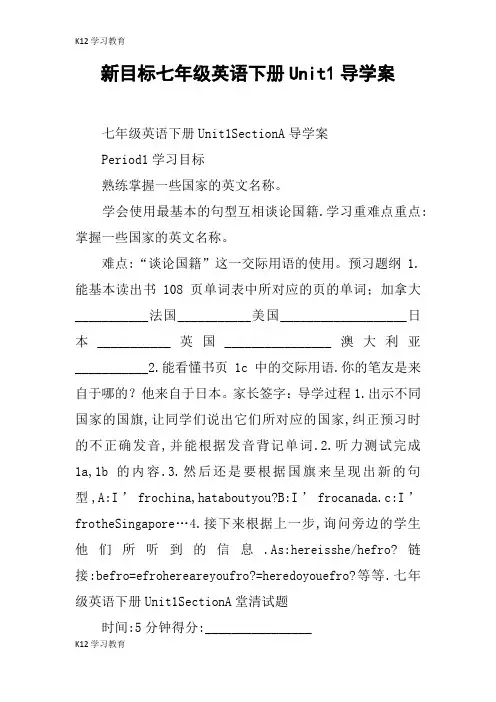
新目标七年级英语下册Unit1导学案七年级英语下册Unit1SectionA导学案Period1学习目标熟练掌握一些国家的英文名称。
学会使用最基本的句型互相谈论国籍.学习重难点重点:掌握一些国家的英文名称。
难点:“谈论国籍”这一交际用语的使用。
预习题纲1.能基本读出书108页单词表中所对应的页的单词;加拿大___________法国___________美国___________________日本___________英国________________澳大利亚___________2.能看懂书页1c中的交际用语.你的笔友是来自于哪的?他来自于日本。
家长签字:导学过程1.出示不同国家的国旗,让同学们说出它们所对应的国家,纠正预习时的不正确发音,并能根据发音背记单词.2.听力测试完成1a,1b的内容.3.然后还是要根据国旗来呈现出新的句型,A:I’frochina,hataboutyou?B:I’frocanada.c:I’frotheSingapore…4.接下来根据上一步,询问旁边的学生他们所听到的信息.As:hereisshe/hefro?链接:befro=efrohereareyoufro?=heredoyouefro?等等.七年级英语下册Unit1SectionA堂清试题时间:5分钟得分:________________七年级英语下册Unit1SectionA导学案Period2学习目标熟练掌握一些城市的英文名称,知道它们是所属于哪一个国家的。
归纳出不同国家的人都说什么语言;哪些国家的人说相同语言..询问人们居住的城市,并会回答。
学习重难点重点:掌握一些国家里有名的城市,以及不同国籍的人所说的语言.难点:询问人们居住的城市,以及它们所说的语言预习题纲1.能基本读出书108页单词表中所对应的第2-3页的单词;悉尼__________多伦多__________巴黎___________纽约________________东京____________居住____________语言______________2.能看懂书页2d和3b中的交际用语.她住在哪?她住在东京。
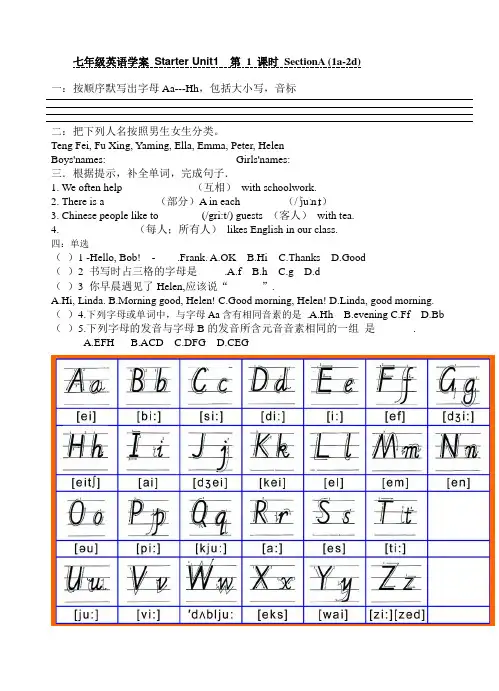
七年级英语学案Starter Unit1 第 1 课时SectionA (1a-2d)一:按顺序默写出字母Aa---Hh,包括大小写,音标二:把下列人名按照男生女生分类。
Teng Fei, Fu Xing, Yaming, Ella, Emma, Peter, HelenBoys'names:________________________Girls'names:_____________________________ 三.根据提示,补全单词,完成句子.1. We often help_____ ______(互相)with schoolwork.2. There is a _________(部分)A in each________(/ˈjuːnɪt)3. Chinese people like to________(/gri:t/) guests (客人)with tea.4.______________(每人;所有人)likes English in our class.四:单选()1 -Hello, Bob! -____.Frank. A.OK B.Hi C.Thanks D.Good()2 书写时占三格的字母是_____.A.f B.h C.g D.d()3 你早晨遇见了Helen,应该说“______”.A.Hi, Linda.B.Morning good, Helen!C.Good morning, Helen!D.Linda, good morning. ()4.下列字母或单词中,与字母Aa含有相同音素的是_.A.Hh B.evening C.Ff D.Bb ()5.下列字母的发音与字母B的发音所含元音音素相同的一组是_______.A.EFHB.ACDC.DFGD.CEG()6下列各项中,与字母Ee含有相同元音音素的一项是_______.A.FfB.DdC.AaD.Ii()7.字母“Gg”和字母“_______”具有相同的音素。
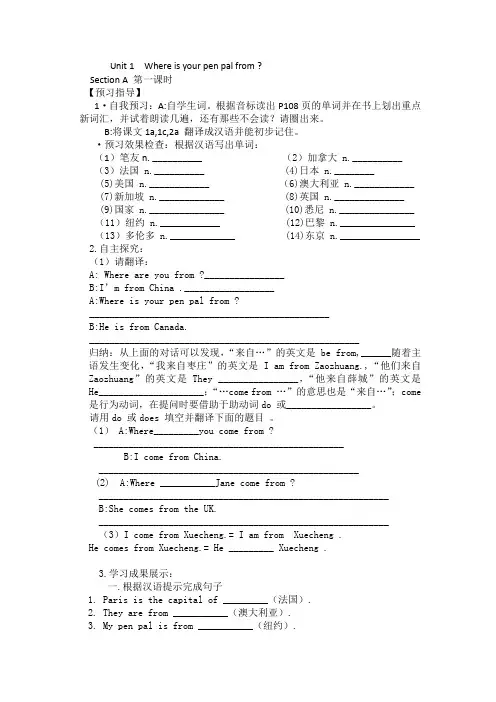
Unit 1 Where is your pen pal from ?Section A 第一课时【预习指导】1·自我预习:A:自学生词。
根据音标读出P108页的单词并在书上划出重点新词汇,并试着朗读几遍,还有那些不会读?请圈出来。
B:将课文1a,1c,2a 翻译成汉语并能初步记住。
·预习效果检查:根据汉语写出单词:(1)笔友n.__________ (2)加拿大 n.__________ (3)法国 n.__________ (4)日本 n.________(5)美国 n.____________ (6)澳大利亚 n.____________(7)新加坡 n._____________ (8)英国 n.______________(9)国家 n._______________ (10)悉尼 n._______________(11)纽约 n.____________ (12)巴黎 n._______________ (13)多伦多 n._____________ (14)东京 n.________________ 2.自主探究:(1)请翻译:A: Where are you from ?________________B:I’m from China .__________________A:Where is your pen pal from ?________________________________________________B:He is from Canada.______________________________________________________归纳:从上面的对话可以发现,“来自…”的英文是be from,______随着主语发生变化,“我来自枣庄”的英文是I am from Zaozhuang.,“他们来自Zaozhuang”的英文是They ________________,“他来自薛城”的英文是He_____________________;“…come from …”的意思也是“来自…”;come 是行为动词,在提问时要借助于助动词do 或_________________。
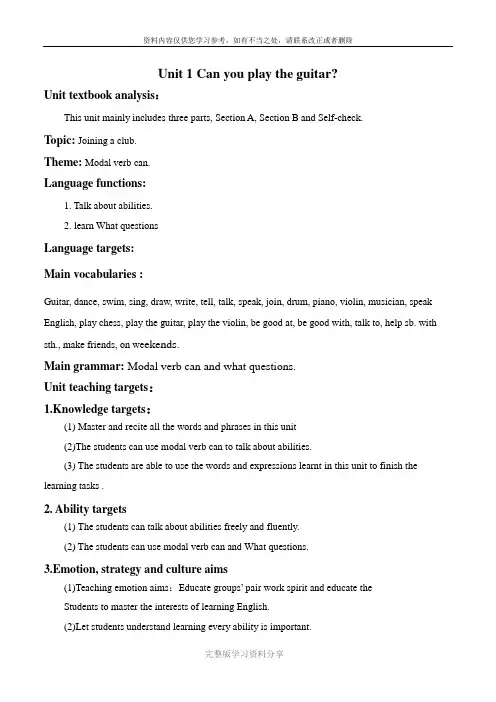
Unit 1 Can you play the guitar?Unit textbook analysis:This unit mainly includes three parts, Section A, Section B and Self-check.Topic: Joining a club.Theme:Modal verb can.Language functions:1. Talk about abilities.2. learn What questionsLanguage targets:Main vocabularies :Guitar, dance, swim, sing, draw, write, tell, talk, speak, join, drum, piano, violin, musician, speak English, play chess, play the guitar, play the violin, be good at, be good with, talk to, help sb. with sth., make friends, on we ekends.Main grammar: Modal verb can and what questions.Unit teaching targets:1.Knowledge targets:(1) Master and recite all the words and phrases in this unit(2)The students can use modal verb can to talk about abilities.(3) The students are able to use the words and expressions learnt in this unit to finish the learning tasks .2. Ability targets(1) The students can talk about abilities freely and fluently.(2) The students can use modal verb can and What questions.3.Emotion, strategy and culture aims(1)Teaching emotion aims:Educate groups’ pair work spirit and educate theStudents to master the interests of learning English.(2)Let students understand learning every ability is important.(3)Strategy aims: let students feel, understand , experience and practice in activities, improve their ability of the language usage and deepen their basic knowledge memory.(4)Culture aims: Let students learn the knowledge of clubs.Unit teaching key points:(1)Learn all the words and phrases by hearts.(2)Learn how to talk about abilities using the modal verb can .Unit teaching emphasis:(1) Let students learn the words and expressions learnt in this unit.(2) Modal verb can and what questions .Unit period arrangement:This unit is divided into six periods.The first period:Section A 1a-1cThe second period:Section A 2a-2dThe third period:Section A Grammar Focus-3cThe fourth period:Section B1a—1fThe fifth period:Section B2a—2cThe six period:Revision, self-check and WritingUnit 1 Can you play the guitar?Period 1 Section A 1a – 1cTeaching time :March 23rd,2015Teaching aims :1. Be able to say, read and write these words and phrases:play the guitar, dance, swim, sing, draw, play chess, play the piano, play the violin2. Be able to talk about abilities:---Can you/he/she/it/they … ?--- Yes, I /he/she/it/they can. / No, I /he/she/it/they can’t.Teaching key points:1. New words.2. Target language.Teaching aids: Recorder, books, pictures and multimedia.Lesson type: New teaching.Learning method guidance.1.Self-learning, take an active part in the group’s discussion, cooperate and research.2.Practice in listening, speaking, reading and writing.Teaching process:Step 1. Greetings and Leading-inGreet the whole class as usual. Ask questions like this:T: I want to ask you some questions, Do you like music? S: Yes, we do.T: What can you do?S: I can….Step 2.New words presentation.1.Present the new words with books or PPT: play the guitar, dance, swim, sing, draw, play chess,play the piano, play the violin2.Sum up the phrases about “play” and complete the activity 1aStep 4. Practice1.Ask and answer:T: Can you sing?S1: Yes, I can.S2: No, I can’t.2.Chain work: make their own conversations in pairs and act out.3. Talk about yourself.1.) Ask and answer:T: What can you do? What can’t you do?S1:I can...But I can’t …S2: I can…and….But I can’t …or….2).Make conversations with “he, she, it, they” in pairs using pictures on ppt like this:A: What can he do? B: He can dance?A:Can he dance? B: Yes, he can.3).Look and guess.(Show some pictures about special people to practice).T: Can she…?S: Yes, she can./No ,she can’t.She can’t walk(走), but she can play tennis.Step 5 Make a survey and give a report.Report: In our group, I can…and …,but I can’t…or…Jack can…and…,but he can’t…or…Step 6 .SummaryStep 7. HomeworkBlackboard Design:Unit 1 Can you play the guitar?Period 1 Section A 1a – 1c--- Can you/he/she/it/they … ?--- Yes, I /he/she/it/they can. / No, I /he/she/it/they can’t. After teachingUnit 1 Can you play the guitar?Period 2 Section A 2a – 2d Teaching time :March 23rd,2015Teaching aims :1. Be able to say, read and write these words:be good at, tell, story, join , club, the story telling club2. Be able to listen and speak the following:---What club do you want to join? ---I want to join t the … club.---What club does he/she want to join? ---He /She wants to join the … club. Teaching key points:1. New words.2. Conversation.Teaching aids: Recorder, pictures and multimedia and teaching case.Lesson type:New teaching.Learning method guidance.1.Self-learning, take an active part in the group’s discussion, cooperate and research.2. Practice in and out of class and listening, speaking, reading and writing. Teaching process:Step1.Revisions1.Words and phrases.2.Make conversations with the sentence structures.Step 2.Free talk to lead inThere are going to be many clubs in our school this term. What club do you want to join? Step 3.New words presentation1.Help students list the names of clubs2.Learn the new words by making sentences or ppt.Step 4. Practice1. Ask and answer:T: What club do you want to join? S: I want to join t the … club.T: Can you …? S: Yes, I can./ No, I can’t.2. Make conversations in pairs and act out.3. Chain work:T: What club do you want to join? S1 : I want to join t the … club.T: Can you …? S1: Yes, I can./ No, I can’t.T: What club does he/she want to join? S2: He /She wants to join t the … club.T: Can he/she …? S2:Yes, he/she can./ No, He/She can’t. Step 4. Work on 2d (2b, 2d )1. Look at the picture in 2a. Then circle the clubs we hear.2. Listen to the recording again. Complete the sentences.3. Look at 2b and talk about what the people can do and the clubs they want to join. Step 5. Work on 2d (Role-play)1. Read the conversation several times until they can read correctly and fluently.2. Read and answer the following questions:1).What club does Bob want to join? 2).What club does Jane want to join?3).What sports can Bob play? 4).Can Jane tell stories well?5).Does Jane like to draw?2. Let Ss read the conversation in pairs. Then try to act out the conversation.3. Read and explain the notes in groups: be good at…=do well in join/ take part in Step 6. Have a test.SBlackboard Design:Unit 1 Can you play the guitar?Period 2 Section A 2a – 2d…What club do you want to join? …I want to join t the … club.…Can you …? …Yes, I can./ No, I can’t.After teachingUnit 1 Can you play the guitar?Period 3 Section A Grammar-3c Teaching time :March 23rd,2015Teaching aims :1. Continue learning to use sentences:---Can you draw? ---Yes , I can.---Can you swim? ---No, I can’t.---What club do you want to join? ---I want to join the chess club.---Can he /she play chess? --- Yes , he/she can.2. Help students learn to sum up the usage of the modal verb can.Teaching key points:1.learn to sum up the usage of the modal verb can.2.Master the general questions about the word can.Teaching aids: Recorder, pictures and multimedia and teaching case.Lesson type: New teaching.Learning method guidance.1.Self-learning, take an active part in the group’s discussion, cooperate and research.2.Practice in and out of class and listening, speaking, reading and writing.Teaching process:Step 1. Warming- up and revisionReview the general questions about the word “can”.Step 2. Practice1.Ask and answer (Make a conversation to talk about what he/she can do ).2.Make conversations in pairs to talk about what they can do and what they can’t do.)One-minute talk.Topic: I like….I can…and….I want to join the… club…Step3. SurveyAsk your classmates about what they can do and complete the chart,then give a report.Report: My name is ____. I like ____. I can ____.But I can’t _____ . I want to join the____ club. My classmate is _____. He likes____ .He can ___.He can’t ___ .He wants to join the____ club. ...Step4. Grammar focus1. Read the sentences in grammar and sum up the usage of the word “can”.2 .Do some exercises to practice the sentence structures .Step5. Work on 3a,3b1.Fill the blanks tofinish 3a and 3b2.Let some pairs read out the sentences to check their answers.Step 6. Exercises and SummaryStep 7. HomeworkMake at least six sentences with can and can’t.Blackboard Design:Unit 1 Can you play the guitar?Period 3 Section A Grammar-3c---Can you draw? ---Yes , I can.---Can you swim? ---No, I can’t.---What club do you want to join? ---I want to join the chess club.---Can he /she play chess? --- Yes , he/she can.After teachingUnit 1 Can you play the guitar?Period 4 Section B 1a-1fTeaching time :March 23rd,2015Teaching aims :1.Listen ,read and recite the words: drum, piano, violin, play the drums, play the piano, play the violin.2.Continue talking about what one can do.3. Learn to talk about one’s music hobbies and the instruments they can play.Teaching key points:1. New words.2. learn the phrases about playing the instruments.Teaching aids: Recorder, pictures and multimedia and teaching case.Lesson type: New teaching.Learning method guidance.1. Self-learning, take an active part in the group’s discussion, cooperate and research.2 .Practice in and out of class and listening, speaking, reading and writing. Teaching process:Step 1. Warming- up and revision1.The words and phrases2.Conversation practice to talk about what people can do:Step 2. New words presentation1.Show a power point to teach the new words.T: What’s this? S: It’s a piano.T: Can you play the piano? S: Yes, I can./ No, I can’t2.Sum up the phrases about “play”3.Make sentences with words and phrasesStep3 Listening1.1a, students draw lines to match the words with the pictures2. 1b, listen to the recording and number the words you hear in 1a.3. 1c, ask and answer questions about the instruments.4. 1d,listen and circle the words and phrases we hear.5.1e, listen again. Fill in the chart with words and phrases in 1d.Step4. Pair work1. 1f, talk about what Bill, Cindy and Frank can and can’t do.2. Act out their conversations in front of class if time permits.Step5. Have a testDo some exercises on the workbook and reading in unit 1.Step6.Summary and homeworkBlackboard Design:Unit 1 Can you play the guitar?Period 4 Section B 1a-1fAfter teachingUnit 1 Can you play the guitar?Period 5 Section B 2a—2c Teaching time :March 23rd,2015Teaching aims:learn,read and recite the words : also, people, home, be good with,make, make friends, today, help sb. with sth. , center, weekend, on the weekend2. Read, listen and grasp the sentences about how to use the word can.3.Practice reading for the title informationTeaching important and difficult points:1. New words.2. Practice reading for the title informationTeaching aids:pictures and multimedia and teaching case.Lesson type: Reading.Learning method guidance.1.Task reading.2. Practice in and out of class and listening, speaking, reading and writing.Teaching process:Step1. Show learning and teaching aims.Step2. Free talk to lead inStep3. ReadingWork on 2aead the three descriptions about Peter, Alan, and Ma Huan. Underline what they can do.2.Students read the three passages again and answer the questions:What does Peter like to do? What about Ma Huan?Where is Alan?e “he” and “she” to retell the three passages.Work on 2btudents read the ads and match the tiles with them. Then explain the reasons to check the answers.2.Fast read and answer the questions:1).If you want to help old people, what telephone number can you call?2).If you want to help with sports for English-speaking students, who can you call?3). When does the school need people to help teach music to students?2.Read the ads carefully and match each person in 2a with an ad in 2b.And then explain the reasons .Eg: Peter can help with sports in English., because he can play basketball and soccer and he can speak English.4. Read and explain the notes in groups.be good with, be good at, talk to, play games with, tell stories, make friends, call…at…, be busy, need to do, English-speaking students,Step4、Summary and homework.Recite the first passage.Blackboard Design:Unit 1 Can you play the guitar?Period 5 Section B 2a—2cPhrases:at the old people’s home, be free, in July, be good with, be good at, talk to, play games with, tell stories, make friends, call…at…, be busy, after school, speak English, need to do…,English-speaking students, on the weekend/on weekends.Questions:1).If you want to help old people, what telephone number can you call?2).If you want to help with sports for English-speaking students, who can you call?3). When does the school need people to help teach music to students?After teachingUnit 1 Can you play the guitar?Period 6 3a-Self--checkTeaching time :March 23rd,2015Teaching aims:1. Be able to grasp the words and phrases in unit 1..2. To learn to finish the writing task with the word can.Teaching important and difficult points:1. The writing skills about writing an ad that a person wanted;2. be able to use what have learned in the writings and learn to connect the knowledge Teaching aids: pictures and multimediaLesson type: Writing.Learning method guidance.1. Self-learning, take an active part in the group’s discussion, cooperate and research.2. Practice in and out of class and listening, speaking, reading and writing.Teaching process:Step1.Show learning and teaching aims.Step2. Self-learning. Teacher’s saying :Knowledge is power.)Read the words in unit 1 loudly and quickly by themselves and see if they can recite all of them. Check between two groups, then phrases. They can look at the screen and recite.Step 3.Practice1. Finish self-check 1and 22.Ask and answer in pairs about one’s abilities.What can /can’t you do…?What can/can’t he/she do…?3.Write a short passage to finish self check 3.Step4. WritingPre-writingLead in the writing of an ad: ask the students to think about if you want to work for School Music Festival.2. Work on 3a, students complete the ad with the word in the box.2. Show the style and format of an ad to the Ss and teach them how to write an ad: the similar asthe writing in 3a.3. Finish 3a and then read togetherWhile- writingAsk students to try to write an ad by themselves in limited time.Post-writing (Evaluation)1. Ask the Ss to exchange their papers to their partners try to correct the errors each other.2. Chose one paper from each group optionally, and then read to the Ss and ask them to makesome comments3. Show some good sample writings on the screen to the students, and ask them read together Step5. Summary homeworkWrite the words and phrases in this unit without books.Blackboard DesignUnit 1 Can you play the guitar?Period 6 3a-Self--checkWanted ?AD what ?contact address(联系方式) phone numberE-mailAfter teaching。
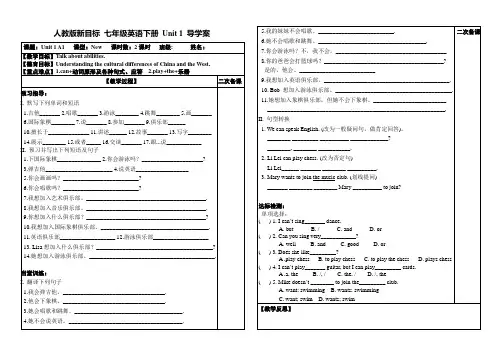
【教学目标】Talk about abilities.【德育目标】Understanding the cultural differences of China and the West.【重点难点】1.can+动词原形及各种句式、应答 2.play+the+乐器【教学过程】二次备课预习指导:I. 默写下列单词和短语1.吉他_______2.唱歌_______3.游泳________4.跳舞________5.画_______6.国际象棋________7.说_______8.参加_______9.俱乐部______10.擅长于______________ 11.讲述______ 12.故事_______ 13.写字________14.展示________ 15.或者_____ 16.交谈_______ 17.跟...说____________II. 预习并写出下列短语及句子1.下国际象棋_______________2.你会游泳吗?_____________________?3.弹吉他_______________________4.说英语__________________5.你会画画吗?__________________________?6.你会唱歌吗?__________________________?7.我想加入艺术俱乐部。
_________________________________________.8.我想加入音乐俱乐部。
_________________________________________.9.你想加入什么俱乐部?_________________________________________?10.我想加入国际象棋俱乐部。
_____________________________________.11.英语俱乐部___________________ 12.游泳俱乐部___________________13. Lisa想加入什么俱乐部?________________________________________?14.她想加入游泳俱乐部。
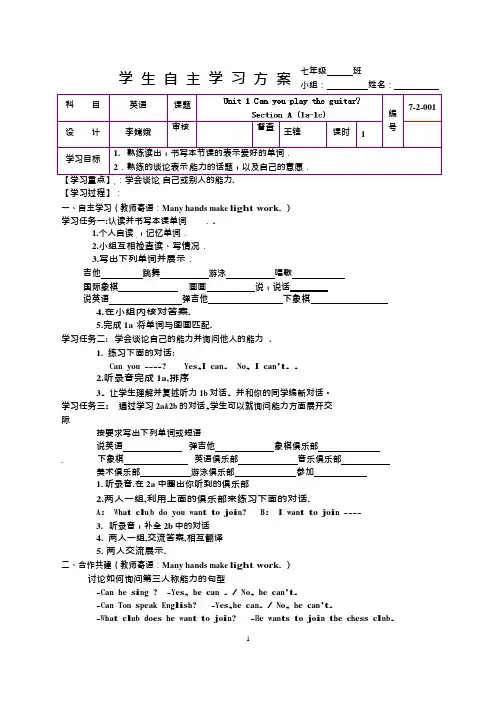
学 生 自 主 学 习 方 案七年级 班小组:姓名:科 目 英语 课题编 号7-2-001设计李嫦娥审核督查王锋课时1学习目标1. 熟练读出,书写本节课的表示爱好的单词. 2.熟练的谈论表示 能力的话题,以及自己的意愿.【学习重点】 :学会谈论 自己或别人的能力. 【学习过程】:一、自主学习(教师寄语:Many hands make light work. ) 学习任务一:认读并书写本课单词 ..1.个人自读 ,记忆单词.2.小组互相检查读、写情况.3.写出下列单词并展示.吉他跳舞游泳唱歌国际象棋 画画 说,说话说英语 弹吉他 下象棋4.在小组内核对答案.5.完成1a 将单词与图画匹配.学习任务二: 学会谈论自己的能力并询问他人的能力 .1. 练习下面的对话: C a n yo u ----? Y e s ,I c a n . N o , I c a n 't . .2.听录音完成1a,排序3. 让学生理解并复述听力1b 对话. 并和你的同学编新对话。
学习任务三: 通过学习2a &2b 的对话,学生可以就询问能力方面展开交际按要求写出下列单词或短语说英语 下象棋 弹吉他 象棋俱乐部 英语俱乐部 音乐俱乐部美术俱乐部 游泳俱乐部 参加1. 听录音.在2a 中圈出你听到的俱乐部2.两人一组,利用上面的俱乐部来练习下面的对话.A : W h a t c l u b d o yo u w a n t t o j o i n ?B : I w a n t t o j o i n ----3. 听录音,补全2b 中的对话4. 两人一组,交流答案,相互翻译5. 两人交流展示.二、合作共建(教师寄语:Many hands make light work. )讨论如何询问第三人称能力的句型-C a n h e s i n g ? -Y e s , h e c a n . / N o , h e c a n 't .-C a n T o m s p e a k E n g li s h ? -Y e s ,h e c a n . / N o , h e c a n 't . -W h a t c l ub d o e s h e w a n t t o j o i n ?-H e w a n t s t o j o i n t h e c h e ss c l ub .1三、系统总结(教师寄语:N o m a n c a n d o t w o t h i n g s a t o n ce.)总结一下在这节课中你所学的俱乐部的名称四、【诊断评价】(教师寄语:N e v er d o t h i n g s b y h a l v e s)(一)选择1.C a n yo u E n g li s h?A.s p e a kB.t a l kC.s ayD.t e ll2.C a n h e b a s k e t b a ll?A.p l ayB.P l ay sC.p l ay i n gD./3.M y b r o t h er w a n t t h e c h e ss c l ub.A.j o i nB.t o j o i nC.j o i n sD.j o i n t o4.M a r y c a n p l ay t h e c h e ss s h e c a n't s w i m.A. a ndB. o rC.bu tD.s o5.H i s b r o t h er p l ay s p i a n o e v er y d ay.A./B. aC. a nD.t h e (二)补全对话A.Can you (唱歌)?B.Y e s,I.C a n yo u(游泳)?A.N o,I w a n t t o j o i n(象棋俱乐部).B.I d o n't li k e(下象棋)A.W h a t c l ub d o yo u w a n t t o ?B.I w a n t t o j o i n(游泳俱乐部)(四)翻译下列句子1. 你会跳舞吗?是的,我会。
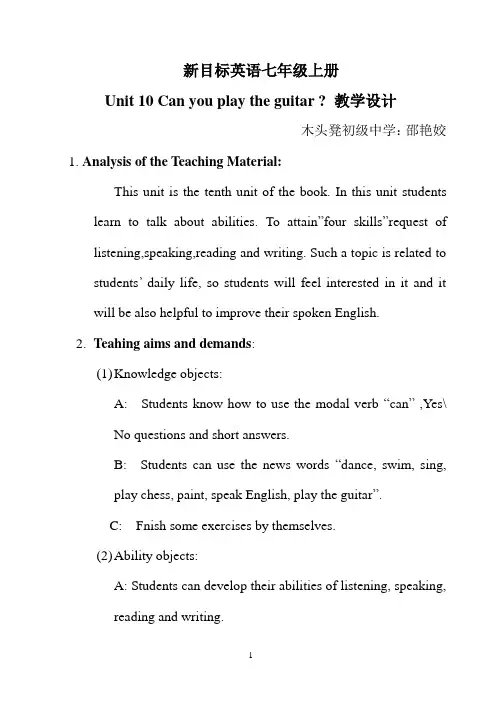
新目标英语七年级上册Unit 10 Can you play the guitar ? 教学设计木头凳初级中学:邵艳姣1. Analysis of the Teaching Material:This unit is the tenth unit of the book. In this unit students learn to talk about abilities. To attain”four skills”request of listening,speaking,reading and writing. Such a topic is related to students’daily life, so students will feel interested in it and it will be also helpful to improve their spoken English.2.Teahing aims and demands:(1)Knowledge objects:A: Students know how to use the modal verb “can” ,Yes\No questions and short answers.B: Students can use the news words “dance, swim, sing,play chess, paint, speak English, play the guitar”.C: Fnish some exercises by themselves.(2)Ability objects:A: Students can develop their abilities of listening, speaking,reading and writing.B: Students can develop their abilities of working in pairsand communication by learning the useful structures.(3)Moral objects:Students can be active in class and show themselves to increase their interest in Eglish learning.3.Teaching keys and difficult points:Key points:1 To train the students to commmunicate with others.2 To enable the students to study and finish the taskin groups and co-operation.Difficult points:Modal word “can”4.Teaching aids:Flash cards ,tape recorder and test paper.5.Teaching procedureStep1: Warm-upSing “Good morning” song.Step2: PresentationT shows the flash cards and teaches the new words one by one. (sing, dance, swim, play chess, paint, play the guitar ,speak English)After the new words learningT: I can speak English,can you speak English?Student1: Yes, I can.T; How about you?Student2: No, I can’t.T: Can he speak English?Student3: No, he can’t.T: Can she speak English?Student4: Yes, she can.Step 3: PracticeFirst play a game, let the students do the actions and guess the words. Then ask them to play a memory game. Ask four or five students to introduce their abilities, at last, let’s see which students can remember all the students’ abilities. Use the sentence :I can……He can……She can……Then play the tape, finish 1b,2a and 2b.Step 4: Production:According to 2b and 2c, teacher gives the students some tasks to make similar dialogues without repetion and find out which group will make more dialogues.Group workMake their own conversations and show the conversation in the front.Student1: What club do you want to join?Student2:I want to join the ……club.Student1: Can you ……?Student2:No, I can’t.Student1:Can you……?Student2: Yes I can.Step 5:practiceHand out the five minutes’test paper. The students finish the exercises in five minutes and teacher checks them.Step 6: Homework:1.Remember all the new words learned.2.Make a dialogue according to 2c.Blackboard designUnit 10 Can you play the guitar?Can you \he \she sing?( dance, swim, play chess) Yes, I \ he\ she can.No, I \he\ she can’t.What club do you want to join?I want to join the art club.。
新目标七年级下册 Units 1-2单元概述本文档将详细介绍新目标七年级下册Units 1-2的教学内容。
该教材旨在帮助学生巩固和扩展他们的英语语言能力,包括听说读写等方面。
Unit 1: Hello!课文概述本单元的主题是问候和自我介绍。
学生将学习如何用英语进行基本的问候、自我介绍和打招呼的表达方式。
通过课文的学习,学生将能够掌握基本的日常英语交流技巧。
重点词汇本单元的重点词汇包括:•hello•hi•goodbye•bye•nice to meet you•my name is•what’s your name•how are you学习目标•学会用英语进行基本的问候和自我介绍。
•掌握常用的日常交流用语。
•能够进行简单的对话并表达个人信息。
教学重点•学会正确使用问候和自我介绍的常用词汇。
•能够流利地用英语进行简短的对话。
教学内容本单元的教学内容包括:1.教师介绍和学生自我介绍2.基本问候和道别的表达方式3.电话问候的用语和礼仪4.模拟对话练习5.与同学互动的练习活动学习评估评估学生对本单元课程的掌握情况可以通过以下方式进行:1.口头问答:教师和学生之间的问答练习,例如问候和自我介绍。
2.小组对话:将学生分成小组进行对话练习,模拟各种真实情境,例如电话问候和面对面问候。
3.作业评估:学生完成书面作业,例如书写自我介绍。
Unit 2: School Life课文概述本单元的主题是学校生活。
学生将学习在学校中所需的常用英语表达方式,包括询问上课时间、交流学习经验和描述学校设施等。
重点词汇本单元的重点词汇包括:•school•class•teacher•student•subject•timetable•library•canteen•playground学习目标•掌握学校生活中常用的英语表达方式。
•能够描述学校设施和活动。
•学会询问和回答有关学校生活的问题。
教学重点•学会正确使用与学校生活相关的词汇。
七年级英语学案Starter Unit1 第 3 课时SectionB (1a-1d)一:按照首字母顺序,排列人名。
Teng Fei, Fu Xing, Yaming, Ella, Emma, Peter, Helen_____________________________________________________________________________________________________二:根据提示,补全单词,完成句子.1.When do you (开始) your class?2.All the students mustn’t go home until there goes the (/bel/).3.It is very helpful for me to have _______________(/ˌkɑːnvərˈseɪʃ(ə)n/) with friends inEnglish every day.4.I can (拼写) the word now. Thank you for helping me.5.—(怎样;如何) is your brother? — He is (健康的; 美好的).三:英汉互译。
1叫我埃玛 2.拼写你的名字 3.去上课________4谢谢你_________5到…的时间了____________6.让我们做某事吧____________四、用括号内所给单词的适当形式填空。
1-How_______your grandmother? -She_______fine, thank you. (be)2.Nice__________ (meet) you, Bob.3. May I___________(know) your name?4. Can you help________with________English? (I)5. Let's__________(go) to school now.五:根据句意,用方框中所给词的适当形式填空。
Unit 1 Can you play the guitar?第一课时Section A 1a—1c姓名:学号:一、学习目标I.知识目标:1.词汇:dance, swim, sing, play chess, paint, speak English, play the guitar, join, can’t=can not2.句型:Can you dance? Yes, I can. /No, I can’t.Can she/he speak English? Yes, she/h e can. No, she/he can’t.What club do you want to join? I/We want to join the basketball club.II.技能目标:1.学习各种课外活动的说法 2.学习情态动词can的用法3.运用情态动词can “询问和谈论能力”III.情感目标:鼓励学生在小组活动中取得进步,并且自信的说Yes,Ican.二、预习内容:I.你能用英语读出下列单词和短语吗?并试着写下来1.跳舞________2.游泳_______3.唱歌___________4.画画___________5.加入,参加6.下象棋_________7.弹吉他_________8.说英语__ __ _____9.英语俱乐部 ___________10.象棋俱乐部____________ 11.游泳俱乐部______________II.你能通过预习说出下的句子吗?1.-你会游泳吗? ______ you _______? –不,我不能。
No, .2.我想参加艺术俱乐部。
I _____ to join the __ ___ ___ __.Ⅲ.预习之后的疑问是三、学习过程:1.检查预习情况。
2.由排球、篮球等实物,引出can的句型3.由问答的形式引出本课重点单词和短语,并用句型练习单词和短语:I can…but I can’t…3.完成1a的词语与人物的匹配。
新目标七年级英语下册全册学案1Unit 1 here’s ur pen pal fr?Setin ATeaher’s rds: Atins spea luder than rds知识目标:1 rds: anada, Frane, apan, the United States, Australia, Singapre, the United ingd, Sdne, Ne r, Pairs, Trnt, T, Frenh, apanese, pal, untr, live, language, rld, lie, dislie2 Phrases: tal abut, be fr/ e fr, pen pal, spea English, a little与little 的区别,favrite subet, tell sb abut sth, lie ding sth3 Iprtant sentenes: 1) --- here’s ur pen pal fr?2) --- here des he live?3) --- hat language des he spea?4) ---- hat’s ur favrite subet?预习检测:1自______________ 2笔友______________3做运动______________ 4讲英语______________给某人写信______________ 6住在______________7一点法语______________ 8 太难______________9去看电影______________ 10喜欢做某事______________情景导入:1 T sh a pht f Sdne and tal abut it2 T as the students se questins自主探究:1 The students pen the bs, turn t Page 81 and read the first letter After that, the students anser three siple questins2 The students read after the tape and g n ansering se re questinsⅣ、合作交流:1The students read the letters that the teaher gives the and then hse ne pen pal the lie2D a reprtpartner’s nae is _________ His ne pen pal’s nae is ________He is _______ ears ld He is fr __________He lives in ___________ At shl, he lies ______________His favrite ___________ is __________________I thin he an be partner’s pen pal D u thin s?拓展创新:Grupr1Disussin: In ur grup, d u lie ur pen pals? h lies? h? ( Tell se reasns )2ReprtIn ur grup, ________f us lie h is pen pal Beause his pen pal …达标测试:一、首字母填空1 She l_______ in Bei Hai2 hat l _______des aria spea?3 here are ur friend f_______?4 ing’s f_______ vie is the Lng eeend hina is a great _______6 r Brn is fr A_______7 an he spea _______ ?8 Rush Hur is an atin _______9 It is an i_______ str10 _______ is the seventh nth in the ear二、单选( )1 _______ d u e fr?A henB H here D h( )2Sa lies_______ his friendsA t plaB plas pla ith D plaing ith ( )3She lives_______ SdneA atB n in D behind( )4here_______ she ? ---In AustraliaA d; liveB des; lives d; lives D des; live ( )D u ant_______ Frenh?A t learnB learns learning D learn三、完形填空:阅读下面短,掌握其大意,然后从各题所给的四个选项中选出最佳答案,并将其标号填入括号内。
学法与教法Unit 1 Where’ s your pen pal from?第一课时(Section A 1a~1C)一、学习目标:1、学会用英语回答笔友的国籍、地址2.掌握下列单词:pen pal, Australia, Japan, Canada, France French, the United States,Singapore, the United Kingdom,3. 重点句型:1. Where …from?句型2. He /She/ is from….重点语法:where构成的特殊疑问句。
二、预读:【预习重点】:1. 试读下列单词:be from 来自pen pal 笔友= pen friend Canada 加拿大加拿大人是CanadianFrance 法国French 法国人;法语Japan 日本Japanese日本人;日语Australia 澳大利亚Australian 澳大利亚人Singapore 新加坡Singaporean新加坡人the United States 美国the United Kingdom 英国China 中国Chinese中国人2.朗读下列句子:A:Where is your pen pal from?B: He’s from Australia.【预习练习】1. 你能用英文写出下列国家名称吗?加拿大_____________ 法国____________ 日本_________ 美国________________澳大利亚______________ 新加坡___________ 英国_______________中国____________2. 用动词的正确形式填空1)Where ___________(be)the book?2)Where ____________(be ) the socks?3)I ___________ (have) a soccer ball. Linda ___________(have ) twobaseballs.4)We _________ ( not like ) math. He ___________ (like ) English5)She ___________(not like ) P.E . ________ Tom _______(want ) to go toa movie?3. 根据答语写问句。
1) Q:_____________________________________________?A:She’s from China.2) Q:_______________________________________________?A:My pen pal’s name is Jodie.4. 心理准备学法与教法通过预习,你发现有哪些问题?_________________________________________________________________三、思悟1、live in,live on或live at的区别。
2、where的特殊疑问句的构成和回答,并试造句。
四、探究Where +be +主语+from ?此句型用于询问“某人来自哪里?”或“某人是哪里人?”回答时,from后常跟表示国家或城市的名词。
Eg. Where are you from? 你来自哪里?I’m from France. 我来自法国。
Where do you come from? 你来自哪里?I come from france. 我来自法国。
Where is she from? 她来自哪里?She’s from Canada. 她来自加拿大。
Where does she come from? 她来自哪里?She comes from. Canada. 她来自加拿大。
从上面的例句,从中我们发现:五、检测单词拼写:1. My brother is in (澳大利亚) now .2 China and Singapore are beautiful (国家)3. (伦敦) is the capital of the United Kingdom .4. They are from Japan. They are __________(日本人).用正确的单词填(1).-----Where _______ your pen pal _______?------He’s ________ Canada.(2).-----Where________she ________?------She lives ________ Shanghai.(3). I_______ a pen pal in China.(4).I like ________ to the movies ________ my friends.句型转换:1. Where is the boy from?(改为同义句)Where____the boy ______ _______?2. She does her homework at home ?( 对划线部分提问)_______ _______she _______her homework?3. I live in Beijing. ( 对划线部分提问)_______ _______you live?收获与反思:_________________________________________________________________学法与教法第二课时(Section A 2a~2d)一、学习目标:1. 掌握下列单词:Country Sydney New York Paris Toronto Tokyo live2. 掌握句型:-----Where is your pen pal from, John?-------Where does he live?3学习重点:A:Where does he live?B:He lives in ….二、预读【预习重点】:1.试读下列单词country 国家two countries两个国家city 城市Sydney 悉尼(澳大利亚港口城市)注意澳大利亚首都是堪培拉(Canberra)New York 纽约(美国著名城市)注意美国首都是华盛顿(Washington)Paris 巴黎法国首都Toronto 多伦多(加拿大著名城市)注意加拿大首都是渥太华(Ottawa)Tokyo 东京日本首都live 居住实义动词居住在某地常用“live in + 地点(国家/城市)”2. 朗读下列句子:A: Where is your pen pal from, John?B:He’s from Japan .A:Where does he live?B:He lives in Tokyo.【预习练习】1. 根据预习单词,完成下列词汇并写出汉语意义.c__ntr_( ) l_ve()c___t____( )2.将下列城市写出对应的国家名称。
Beijing_________ London____________ Sydney____________ NewYork____________ Paris_____________ Toronto___________Tokyo______________3.完成下列三个句子。
1) _______ ________your pen pal ___________(来自…… )?2)________does she _________(住在…..)?3) China and Singapore are beautiful (国家)【我不懂的地方】____________________________________________________________________________________________________________三、思悟你知道Where …from? 和Where…live?的用法吗?并试造句学法与教法四、探究1、小组对话练习。
A: Where is John’s pen pal from?B:He’s from Japan .A:Where does he live?B:He lives in Tokyo.2、小组练习展示。
五、检测一. 翻译下列句子:1. 你的笔友来自哪里??2. 她来自日本。
3. Jim的爷爷住在哪里?4. 他住在纽约。
5. 他们来自哪里??6. 他们来自加拿大。
.二. 单项选择( )1.Where_____your pen pal_____? He’s from England.A. are…fromB. is…fromC. does…fromD. is…in( )2. _____does she live? She lives _____ Sydney.A. What/inB. Where/inC. What place/inD. Where/from( )3. These students _____ from _____.A. is/EnglishB. are/JapaneseC. are/FranceD. is/French( )4. Where does he _______ from?A comes B. come C. coming D. /三.抄写并背诵本课时的单词和句子。
___________________________________________________________________________________________________________________________________________________________________________________________________收获与反思:___________________________________________________________________________________________________________________________________________________________________________________________________学法与教法第三课时(Section A 3a~4)一、学习目标:1. 掌握下列单词:language2. 能力目标:(1)掌握谈论国家,国籍和语言。